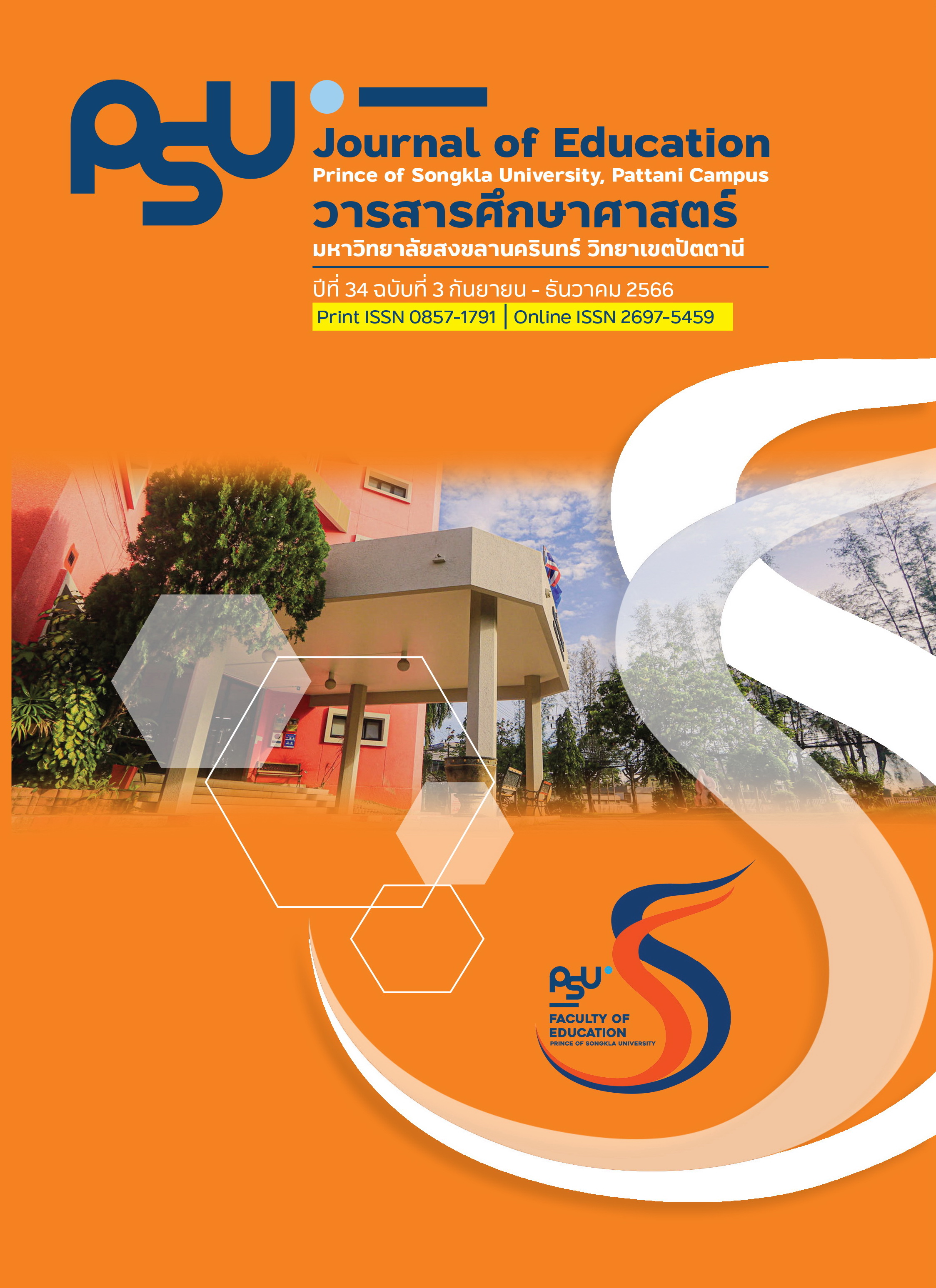ผลการจัดประสบการณ์การเรียนรู้ผ่านกิจกรรมภูมิศิลป์ที่มีต่อความคิดสร้างสรรค์ของเด็กปฐมวัยในโรงเรียนบ้านตลิ่งชัน
Main Article Content
บทคัดย่อ
การวิจัยครั้งนี้มีจุดประสงค์เพื่อศึกษาผลการจัดประสบการณ์การเรียนรู้ผ่านกิจกรรมภูมิศิลป์ที่มีต่อความคิดสร้างสรรค์ของเด็กปฐมวัยในโรงเรียนบ้านตลิ่งชัน ประชากรที่ใช้ในการวิจัยในครั้งนี้ คือ เด็กปฐมวัยชายและหญิงจำนวน 7 คน ที่มีอายุระหว่าง 5-6 ปี ซึ่งกำลังศึกษาอยู่ในชั้นอนุบาล 3 ภาคเรียนที่ 1 ปีการศึกษา 2565 โรงเรียนบ้านตลิ่งชัน อำเภอเหนือคลอง จังหวัดกระบี่ สังกัดสำนักงานเขตพื้นที่การศึกษาประถมศึกษากระบี่ เขต 1 เครื่องมือวิจัย ประกอบด้วย แผนการจัดประสบการณ์การเรียนรู้ผ่านกิจกรรมภูมิศิลป์ของเด็กปฐมวัย แบบประเมินความคิดสร้างสรรค์เชิงปฏิบัติการของเด็กปฐมวัย และแบบสังเกตพฤติกรรม วิเคราะห์ข้อมูลโดยใช้ค่าเฉลี่ย ค่าเบี่ยงเบนมาตรฐาน คะแนนพัฒนาการสัมพัทธ์ และการวิเคราะห์เนื้อหา ผลการวิจัยพบว่า เด็กปฐมวัยมีคะแนนเฉลี่ยความคิดสร้างสรรค์หลังการทดลอง (μ=10.52) สูงกว่าคะแนนเฉลี่ยก่อนการทดลอง (μ=6.10) นอกจากนี้ ค่าเฉลี่ยของคะแนนพัฒนาการสัมพัทธ์เท่ากับ 75.60 คะแนน ซึ่งอยู่ในเกณฑ์พัฒนาการระดับสูง ผลจากการสังเกตพฤติกรรมพบว่าเด็กสามารถเลือกวัสดุธรรมชาติ เพื่อนำมาออกแบบสร้างสรรค์ผลงานให้มีความแปลกใหม่ สามารถใช้วัสดุได้หลากหลายโดยไม่ยึดติดกับวัสดุชนิดเดิม และตกแต่งผลงานให้มีความสมบูรณ์ได้อย่างรวดเร็วภายในระยะเวลาจำกัดได้
Article Details

อนุญาตภายใต้เงื่อนไข Creative Commons Attribution-NonCommercial 4.0 International License.
เอกสารอ้างอิง
Alsina, A., & Salgado, M. (2021). Land Art Math: A STEAM Activity to Promote Mathematical Competence in Early Childhood Education. Education Mathematics Education in Childhood, 7(1), 1-11.
Behnamnia, N., Kamsin, A., Ismail, M., & Hayati, A. (2020). The Effective Components of Creativity in Digital Game-Based Learning Among Young Children: A Case Study. Children and Youth Services Review, 116, 1-13.
Bourotzoglou, E. A. (2018). Art, Cultural Heritage and Parent Counselling Activities, as Pioneering Practices for Kindergarten Class Management. Journal of Contemporary Education, 2, 20-26.
Erdem, C., Bagci, H., & Kocyigit, M. (2019). 21st Century Skills and Education. Cambridge Scholars Publishing.
Ernst, J., & Burcak, F. (2019). Young Children’s Contributions to Sustainability: The Influence of Nature Play on Curiosity, Executive Function Skills, Creative Thinking, and Resilience. Sustainability, 11(15), 1-22.
Fitriyati, N. R., Himah, N., & Rohadi, R. (Eds.). (2019). Proceeding of 1st Conference of English Language and Literature (CELL). https://shorturl.asia/RNmQp
Glaveanu, V. P., Hanchett Hanson, M., Baer, J., Barbot, B., Clapp, E. P., Corazza, G. E., Hennessey, B., Kaufman, J. C., Lebuda, I., Lubart, T., Montuori, A., Ness, I. J., Plucker, J., Reiter-Palmon, R., Sierra, Z., Simonton, D. K., Neves-Pereira, M. S., & Sternberg, R. J. (2019). Advancing Creativity Theory and Research: A Socio-Cultural Manifesto. The Journal of Creative Behavior, 54(3), 741-745.
Guilford, J. P. (1967). Creativity: Yesterday, today, and tomorrow. The Journal of Creative Behavior, 1(1), 3–14.
Handayani, P. H., Gandamana, A., and Farihah, D. (2017). Development of Creativity Early Childhood in the Family. Journal of Healthy and Prosperous Family, 15(2), 46-55.
Hidayah, A. F. (2019). The Effect of Pop Up Book Activities On Group A’s Early Childhood Creativity. Early Childhood research Journal, 2(1), 30-40.
Kanchanawasri, S. (2009). Classical test theory. Bangkok: Chulalongkorn University Printing House. [in Thai]
Nanthalad, P. (2017). Arts for Young Children. Udon Thani: Udon Thani Rajabhat University. [in Thai]
Oncu, E. C. (2016). Improved creative thinkers in a class: A model of activity based tasks for improving university students creative thinking abilities. Educational Research and Reviews, 11(8), 517-522.
Pang, W. (2015). Promoting creativity in the classroom: A generative view. Psychology of Aesthetics, Creativity, and the Arts, 9(2), 122-127.
Phumket, S. (2017). A Development of an Art Activity from Natural Materials to Enhance Creative Thinking in Early Childhood Children. [Master of Education, Naresuan University]. Naresuan University Library. [in Thai]
Phungching, S. (2019). The Effect of Art Activities with Natural Materials of SSAPA+c Model to Improve Self-Regulation and Creative Thinking of Young Children. [Master of Education, Silpakorn University]. The Central Library of Silpakorn University. [in Thai]
Piaget, J. (1969). The psychology of the child. New York: Basic Books.
Sakuldee, S. (2018). The Development of Creative Thinking by Using Fables for Kinder garten 1. [Master of Education, Dhurakij Pundit University]. Learning Center and Library Dhurakij Pundit University. [in Thai]
Sailamai, B. (2015). The Development of Creative Thinking for Preschool Children Through STEM Education Learning Experience Provision on Local Careers in Songkhla Province. [Master of Education, Kasetsart University]. KU Knowledge Repository. [in Thai]
Serbu, G. A. (2020). Creativity and Preschool Education – Imperatives to an Harmonious Development of the Child. International Journal of Educational Sciences, 2(3), 60-67.
Shilling, R., & Brooklyn, J. (2010). Land Art for Kids. Blurb.
Tantipalachiwa, K. (2008). Learning management for early childhood. Bangkok: Brain-Base Books. [in Thai]
Tegano, D. W., Moran, J. D., & Sawyer, J. K. (1991). Creativity in Early Childhood Classrooms.
Totes, P., Bunbhub, B., Eaknava, N., Promdecha, C., Upaphong, S., Nuanyoung, N., Inprayoon, S., & Limpakuptathavorn, A. (2014). The concept of “Nature” in contemporary art in Europe and America. Silpakorn University Journal of Fine Arts, 2(1), 195-234. [in Thai]
Vygotsky, L. S. (1978). Mind in Society: Development of Higher Psychological Processes. Cambridge, Massachusetts: Harvard University Press.
Williams, M. K. (2017). John Dewey in the 21st Century. Journal of Inquiry & Action in Education, 9(1), 91-102.
Wojciehowski, M., & Ernst, J. (2018). Creative by Nature: Investigating the Impact of Nature Preschools on Young Children’s Creative Thinking. International Journal of Early Childhood Environmental Education, 6(1),


